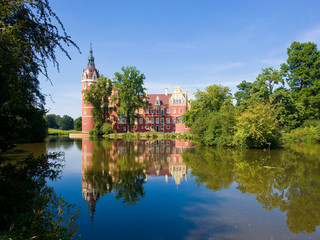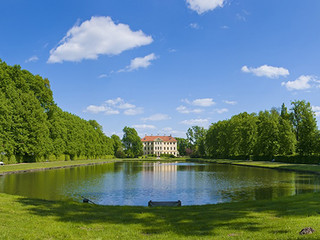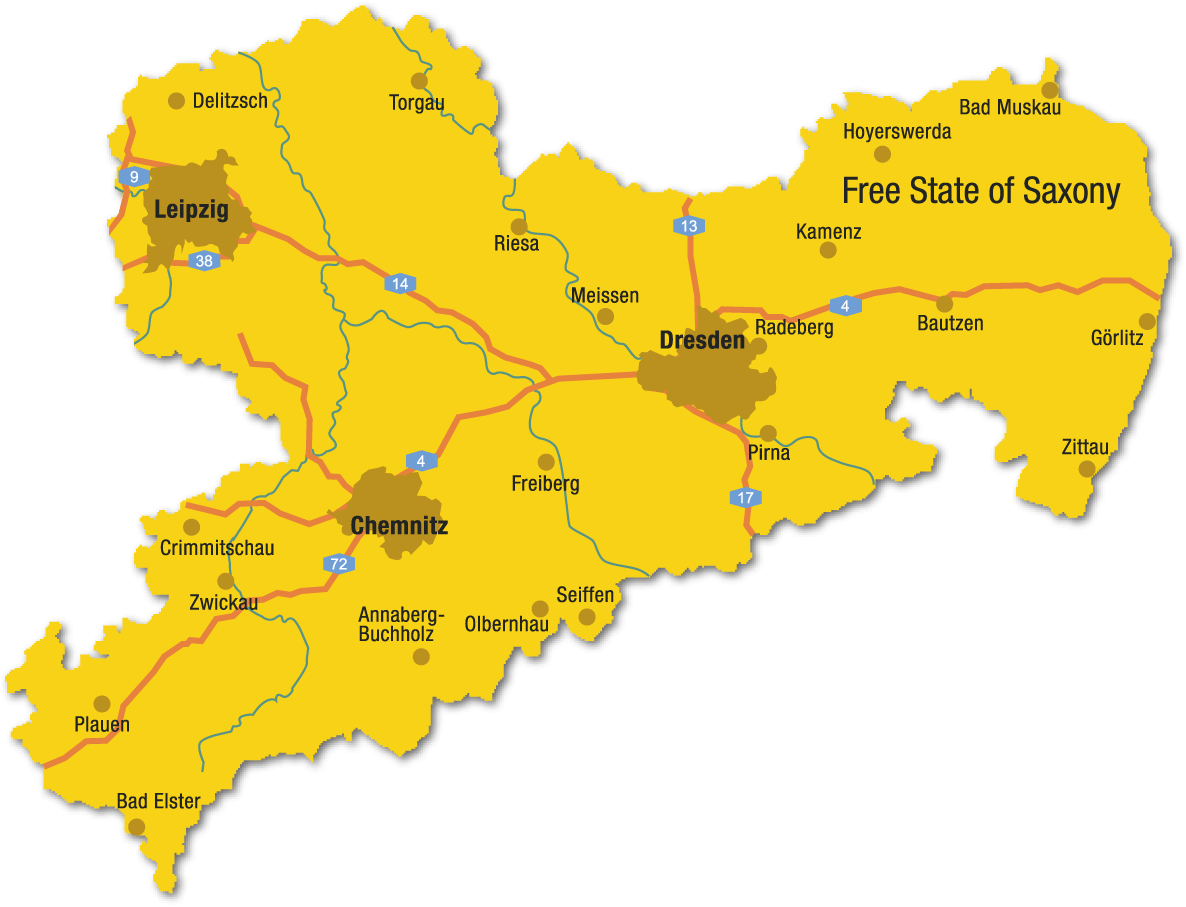Take a walk through Saxony’s most beautiful gardens, allow to be inebriated by the scents of flowers and herbs, experience unexpected views and gain undreamt-of insights.
Relax by strolling through the spacious gardens in sunshine, accompanied by the splashing of fountains.
And take a piece of Schloesserland home with you: a flower bed brick from Bad Muskau, a Camellia shoot from Pillnitz, summer flowers or an Azalea from Weesenstein – all to be purchased in those places.
Prince-Pueckler-Park Bad Muskau (A)
Inspired by English landscapists, Hermann Prince Pueckler-Muskau created a seemingly infinite landscape on 830 hectares with the New Palace at its heart. The Muskau Park, which has been listed as a site of German-Polish UNESCO World Heritage. You can explore the Muskau Park, which has been listed since 2004 as German-Polish UNESCO World Heritage, taking a ride on a horse-drawn coach or riding a bike. This will allow you to experience how Pueckler once created a harmonious piece of landscaping art by ingeniously arranging oak, linden, beech and poplar trees, expansive meadows, skillfully laid-out paths and flower gardens placed around the palace.
After having visited the exhibition on Prince Pueckler at the palace, you should, by no means, miss out on trying the famous Prince Pueckler Icecream at the café.
Details on Prince Pueckler Park in Bad Muskau
Further to Station B – Zabeltitz Baroque Garden, approx. 108 km


Zabeltitz Baroque Garden (B)
Zabeltitz Baroque Garden is among the largest and most important gardens in Saxony that had been designed in French style. Commissioned by Imperial Count von Wackerbarth, the garden was conceived by Johann Christoph Knoeffel, the Court Master Builder of Augustus the Strong from 1728. Gorgeous lime and chestnut avenues, lined by rows of hedges, pleasure groves, rotaries with sandstone sculptures and a unique pond system follow a strictly symmetrical order.
Details about the Zabeltitz Baroque Garden
Further to Station C - Dresden Zwinger, ca. 35 km
The Dresden Zwinger (C)
In 1709, State Supreme Master Builder Matthaeus Daniel Poeppelmann was commissioned by Augustus the Strong to build an orangery in the Zwinger garden of the old premises of the Dresden fortification as the overwintering quarters for orange trees and other potted plants. Later the idea occurred to use the space for court festivities. The Baroque festivity culture was not only for the amusement and entertainment of the court, but also to show off its wealth and sovereign power.
Further to station D - Pillnitz Castle and Park, about 13 km
Pillnitz Castle & Park (D)
Every year, the first joys of spring are brought out by the carmine flowers of the Camellia in the Pillnitz Park. A guided tour of the pleasure garden, the English and Dutch gardens is highly recommended to get to know the precious Wettin collection of plants.
The more than 250-year-old Camellia is a botanical rarity which displays its carmine flowers from February to April in its protective glasshouse.
Lilac trees with their interesting spiral growth and Germany’s oldest citrus plant, also over 250 years old, wait to be admired. The Palm House completed in 1861 accommodates strelitzias, proteas and “kangaroo paws”. Shoots of the famous Camellia can be purchased from February.
Details on Pillnitz Castle and Park
Further to Station E – The Grosssedlitz Baroque Garden, approx. 13km
Gross-Sedlitz Baroque Garden (E)
After Imperial Count von Wackerbarth had sold the garden to Elector Augustus the Strong in 1723, the latter had it re-designed following the French ideal. Only 12 of the projected 96 hectares could be implemented, but are fascinating the visitor all the more.
Today, the expansive, terraced area represents itself as a piece of landscaping art with two orangeries, many trick fountains and about 60 sculptures, including the four seasons, Hera and Zeus. Every year the 400 potted plants leave the orangeries to be set up in the park. With its more than 100 bitter orange trees, the Grosssedlitz collection counts among the largest in the German-speaking lands. A limited supply of the homemade bitter-orange marmalade is for sale at the visitor center in the Upper Orangery.
Details on the Gross Sedlitz Baroque Garden
Further to Station F – Weesenstein Castle, approx. 8km
Weesenstein Castle (F)
The castle park in its baroque appearance and inspired by the French style huddles against the castle setting that is basically of medieval character and that, over the centuries, has grown into an impressive castle complex. Take a relaxing walk in the flower garden and among Sawara cypresses. The Mueglitz River, which divides the park into two parts, was the park’s doom in the 2002 flood. It is first of all thanks to the immediate dedication of the numerous volunteers that its well-known charm could be restored.
The castle, too, proudly presents itself, with its museum inviting the visitor to embark on a time travel through the castle’s 800 years of history. The representation rooms that are of cultural and historical importance, richly equipped with original furniture, decorative accessories and, above all, tapestries of historical value, are unrivalled beyond Saxony’s borders.
Further to Station F - Altzella Monastery Park, approx. 54km
Altzella Monastery Park (F)
Gnarled old trees, intricate paths, fairytale meadows – the Altzella Park appears to be from another world. The medieval monastery ruins accompanied by the romantic flair of the English garden landscape fascinate visitors and invite them to stay for a while. Margrave Otto von Meissen founded the Cistercian monastery in 1162. During the Middle Ages, it used to be the most important one in the region and became the Wettin dynasty’s burial place. The four tombslabs of the founding family can still be seen today. After almost 400 years of prosperity, the monks left the monastery in the wake of Reformation. Left to decay, the ruins lie romantically embedded in meadows today abundant with cowslip, columbine and fumewort. Copper beech give the picturesque landscape park character and allow for numerous views to the surroundings.
Details on Altzella Monastery Park
Further to Station H – Lichtenwalde Castle and Park, approx. 35km
Lichtenwalde Castle & Park (H)
Immediately next to Lichtenwalde Castle, there is the entrance to the ten-hectare Baroque park estate that was created during the transitional stage from Baroque to Rococo. Along several axes of sight and of paths, individual garden spaces reveal splendid avenues, concert gardens and historical trick fountains. What is particularly charming is the sloped setting of the park permitting surprising views into the Zschopau River valley. All year round, the newly designed “Treasury” museum presents exhibits from distant cultures, some of which are several thousand years old and are of immeasurable cultural and historical value.
Details on Lichtenwalde Castle and Park
Further to Station I - The Royal Grounds of Bad Elster, approx. 115 km
Royal Grounds Bad Elster (I)
Laid out in the style of an English landscape park around 1850, the historical spa park with its six individual park areas is an important part of the Royal Grounds Bad Elster and counts among the most beautiful parks in Germany.
Along with the impressive spa architecture in the style of both German Gruenderzeit and Art Nouveau, it forms a harmonic ensemble, which had once been laid out by the greatest landscapists of Europe. Every year, thousands of visitors come to Bad Elster, especially when the famous rhododendrons are blossoming.
